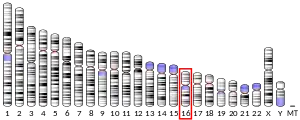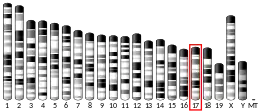SEPX1
Methionine-R-sulfoxide reductase B1 is an enzyme that in humans is encoded by the SEPX1 gene.[5][6]
| MSRB1 | |||||||||||||||||||||||||||||||||||||||||||||||||||
|---|---|---|---|---|---|---|---|---|---|---|---|---|---|---|---|---|---|---|---|---|---|---|---|---|---|---|---|---|---|---|---|---|---|---|---|---|---|---|---|---|---|---|---|---|---|---|---|---|---|---|---|
| |||||||||||||||||||||||||||||||||||||||||||||||||||
| Identifiers | |||||||||||||||||||||||||||||||||||||||||||||||||||
| Aliases | MSRB1, SELR, SELX, SEPX1, SepR, HSPC270, methionine sulfoxide reductase B1, SELENOX, SELENOR | ||||||||||||||||||||||||||||||||||||||||||||||||||
| External IDs | OMIM: 606216 MGI: 1351642 HomoloGene: 8455 GeneCards: MSRB1 | ||||||||||||||||||||||||||||||||||||||||||||||||||
| |||||||||||||||||||||||||||||||||||||||||||||||||||
| |||||||||||||||||||||||||||||||||||||||||||||||||||
| |||||||||||||||||||||||||||||||||||||||||||||||||||
| |||||||||||||||||||||||||||||||||||||||||||||||||||
| Wikidata | |||||||||||||||||||||||||||||||||||||||||||||||||||
| |||||||||||||||||||||||||||||||||||||||||||||||||||
This gene encodes a selenoprotein, which contains a selenocysteine (Sec) residue at its active site. The selenocysteine is encoded by the UGA codon that normally signals translation termination. The 3' UTR of selenoprotein genes have a common stem-loop structure, the sec insertion sequence (SECIS), that is necessary for the recognition of UGA as a Sec codon rather than as a stop signal. This protein belongs to the methionine sulfoxide reductase B (MsrB) family, and it is expressed in a variety of adult and fetal tissues.[6]
See also
References
- GRCh38: Ensembl release 89: ENSG00000198736 - Ensembl, May 2017
- GRCm38: Ensembl release 89: ENSMUSG00000075705 - Ensembl, May 2017
- "Human PubMed Reference:". National Center for Biotechnology Information, U.S. National Library of Medicine.
- "Mouse PubMed Reference:". National Center for Biotechnology Information, U.S. National Library of Medicine.
- Lescure A, Gautheret D, Carbon P, Krol A (Feb 2000). "Novel selenoproteins identified in silico and in vivo by using a conserved RNA structural motif". J Biol Chem. 274 (53): 38147–54. doi:10.1074/jbc.274.53.38147. PMID 10608886.
- "Entrez Gene: SEPX1 selenoprotein X, 1".
Further reading
- Bonaldo MF, Lennon G, Soares MB (1997). "Normalization and subtraction: two approaches to facilitate gene discovery". Genome Res. 6 (9): 791–806. doi:10.1101/gr.6.9.791. PMID 8889548.
- Kryukov GV, Kryukov VM, Gladyshev VN (1999). "New mammalian selenocysteine-containing proteins identified with an algorithm that searches for selenocysteine insertion sequence elements". J. Biol. Chem. 274 (48): 33888–97. doi:10.1074/jbc.274.48.33888. PMID 10567350.
- Zhang QH, Ye M, Wu XY, et al. (2001). "Cloning and functional analysis of cDNAs with open reading frames for 300 previously undefined genes expressed in CD34+ hematopoietic stem/progenitor cells". Genome Res. 10 (10): 1546–60. doi:10.1101/gr.140200. PMC 310934. PMID 11042152.
- Daniels RJ, Peden JF, Lloyd C, et al. (2001). "Sequence, structure and pathology of the fully annotated terminal 2 Mb of the short arm of human chromosome 16". Hum. Mol. Genet. 10 (4): 339–52. doi:10.1093/hmg/10.4.339. PMID 11157797.
- Moskovitz J, Singh VK, Requena J, et al. (2002). "Purification and characterization of methionine sulfoxide reductases from mouse and Staphylococcus aureus and their substrate stereospecificity". Biochem. Biophys. Res. Commun. 290 (1): 62–5. doi:10.1006/bbrc.2001.6171. PMID 11779133.
- Strausberg RL, Feingold EA, Grouse LH, et al. (2003). "Generation and initial analysis of more than 15,000 full-length human and mouse cDNA sequences". Proc. Natl. Acad. Sci. U.S.A. 99 (26): 16899–903. Bibcode:2002PNAS...9916899M. doi:10.1073/pnas.242603899. PMC 139241. PMID 12477932.
- Kim HY, Gladyshev VN (2004). "Methionine sulfoxide reduction in mammals: characterization of methionine-R-sulfoxide reductases". Mol. Biol. Cell. 15 (3): 1055–64. doi:10.1091/mbc.E03-08-0629. PMC 363075. PMID 14699060.
- Gerhard DS, Wagner L, Feingold EA, et al. (2004). "The status, quality, and expansion of the NIH full-length cDNA project: the Mammalian Gene Collection (MGC)". Genome Res. 14 (10B): 2121–7. doi:10.1101/gr.2596504. PMC 528928. PMID 15489334.
This article is issued from Wikipedia. The text is licensed under Creative Commons - Attribution - Sharealike. Additional terms may apply for the media files.



